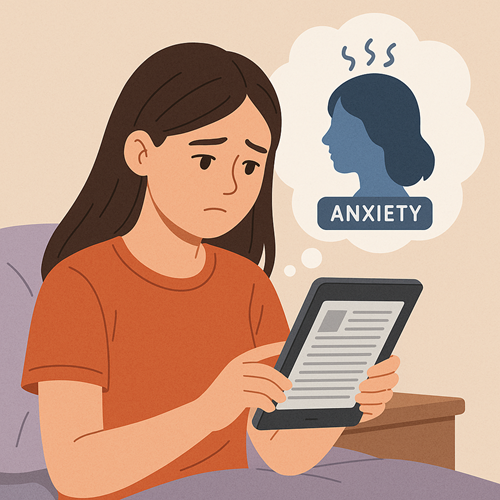Effect of e-book media on adolescent girls’ knowledge of mental health issues anxiety
Abstract
Introduction: Adolescence is a critical developmental stage marked by psychological, emotional, and social changes. Anxiety is among the most common mental health issues faced by adolescents and can significantly affect their academic achievement, social relationships, and overall well-being. This study aimed to examine the effect of e-book media on the knowledge level of adolescent girls regarding mental health issues, specifically anxiety.
Methods: This research employed a pre-experimental design with a one-group pretest–posttest approach. The population consisted of adolescent girls enrolled at Madrasah Aliyah Muhammadiyah Salaka, with 62 respondents selected through total sampling. Data collection used a structured questionnaire measuring knowledge about anxiety-related mental health issues. Statistical analysis was conducted using the Wilcoxon Signed Rank Test through SPSS version 29.0 to compare pretest and posttest scores.
Results: The findings revealed a significant improvement in knowledge after the intervention. Before using e-book media, 54.8% of respondents had low knowledge, 40.3% moderate knowledge, and only 4.8% high knowledge. Following the intervention, 74.2% demonstrated high knowledge and 25.8% moderate knowledge, with no respondents remaining in the low knowledge category. Statistical analysis indicated a p-value of 0.000 (<0.05), confirming a significant effect of e-book media in enhancing knowledge.
Conclusion: E-book media is proven to be an effective educational tool for increasing adolescent girls’ knowledge about mental health, particularly anxiety. Its accessibility and interactive format make it a valuable medium for promoting adolescent mental health literacy in school settings. Future studies are recommended to expand to larger populations and integrate other digital learning resources.
Downloads
References
Aghabozorgi, K. et al. (2024) ‘How university blue and green space affect students’ mental health: A scoping review’, Urban Forestry & Urban Greening, 97, p. 128394. doi: https://doi.org/10.1016/j.ufug.2024.128394.
Andrews, J. G. et al. (2025) ‘A mixed methods exploratory study assessing youth knowledge, self-efficacy and mental health outcomes in transition to adult healthcare’, Health Care Transitions, 3, p. 100096. doi: https://doi.org/10.1016/j.hctj.2025.100096.
Costa e Silva, M. R. do V. et al. (2025) ‘Interventions to improve parental mental health and psychological well-being in parents of adolescents with a diagnosis of ASD and/or ADHD: A systematic review’, Research in Autism, 126, p. 202649. doi: https://doi.org/10.1016/j.reia.2025.202649.
Crane, M. E. et al. (2025) ‘Children’s Literature on Anxiety: A Systematic Review and Content Analysis’, Behavior Therapy. doi: https://doi.org/10.1016/j.beth.2025.05.003.
Danese, A. et al. (2025) ‘Scoping Review: Digital Mental Health Interventions for Children and Adolescents Affected by War’, Journal of the American Academy of Child & Adolescent Psychiatry, 64(2), pp. 226–248. doi: https://doi.org/10.1016/j.jaac.2024.02.017.
Jin, Y. et al. (2025) ‘The Applications of Large Language Models in Mental Health: Scoping Review’, Journal of Medical Internet Research, 27. doi: https://doi.org/10.2196/69284.
Limpanopparat, S., Gibson, E. and Harris, D. A. (2024) ‘User engagement, attitudes, and the effectiveness of chatbots as a mental health intervention: A systematic review’, Computers in Human Behavior: Artificial Humans, 2(2), p. 100081. doi: https://doi.org/10.1016/j.chbah.2024.100081.
Lin, X. et al. (2025) ‘Quality and Privacy Policy Compliance of Mental Health Care Apps in China: Cross-Sectional Evaluation Study’, Journal of Medical Internet Research, 27. doi: https://doi.org/10.2196/66762.
Lisa De Panfilis et al. (2025) ‘“When you’re in the office, it means you managed to get somewhere”: An interpretive descriptive study of the perceptions of adolescents accessing primary care for mental health services’, Health Care Transitions, 3, p. 100093. doi: https://doi.org/10.1016/j.hctj.2024.100093.
Manning, N. (2024) ‘Affordances, mental health and psychiatry’, SSM - Mental Health, 6, p. 100376. doi: https://doi.org/10.1016/j.ssmmh.2024.100376.
McKellar, L. et al. (2024) ‘Evaluation of a pilot online education program to develop midwives’ knowledge, skill and confidence in perinatal mental health in rural South Australia’, Women and Birth, 37(2), pp. 355–361. doi: https://doi.org/10.1016/j.wombi.2023.11.005.
McLane, L. et al. (2024) ‘Examining the value of mental health awareness training for soccer coaching license candidates’, Apunts Sports Medicine, 59(224), p. 100459. doi: https://doi.org/10.1016/j.apunsm.2024.100459.
Okumu, M. et al. (2025) ‘eHealth literacy and digital health interventions: Key ingredients for supporting the mental health of displaced youth living in the urban slums of kampala, Uganda’, Computers in Human Behavior, 162, p. 108434. doi: https://doi.org/10.1016/j.chb.2024.108434.
Pennacchia, J. M. et al. (2025) ‘Assessing mental health of people with complex communication needs: A systematic review.’, Journal of Communication Disorders, 113, p. 106494. doi: https://doi.org/10.1016/j.jcomdis.2025.106494.
Pineault, J. et al. (2025) ‘Gentrification and mental health inequities: a scoping review’, Social Science & Medicine, 384, p. 118547. doi: https://doi.org/10.1016/j.socscimed.2025.118547.
Putri, S. Z., Bachtiar, S. M. and Suprapto, S. (2025) ‘A Descriptive Case Series on Combined Education, Breast Care, and Oxytocin Massage for Lactation Support in Indonesia’, Journal of Public Health Sciences, 4(02), pp. 165–179. doi: https://doi.org/10.56741/IISTR.jphs.001030.
Qu, D. et al. (2024) ‘School mental health prevention and intervention strategies in China: a scoping review’, The Lancet Regional Health - Western Pacific, 53, p. 101243. doi: https://doi.org/10.1016/j.lanwpc.2024.101243.
Ramos Miguel, R. et al. (2024) ‘Effectiveness of mental-health interventions for children and adolescents placed in residential care by the welfare services: A systematic review’, Children and Youth Services Review, 166, p. 107929. doi: https://doi.org/10.1016/j.childyouth.2024.107929.
Reinhart, A. et al. (2025) ‘Barriers to accessing and using preventive mental health services for psychosocially strained children and families in Germany: Perspectives of professionals from different sectors’, Preventive Medicine, 200, p. 108392. doi: https://doi.org/10.1016/j.ypmed.2025.108392.
Ruiz-Ranz, E. and Asín-Izquierdo, I. (2025) ‘Physical activity, exercise, and mental health of healthy adolescents: A review of the last 5 years’, Sports Medicine and Health Science, 7(3), pp. 161–172. doi: https://doi.org/10.1016/j.smhs.2024.10.003.
Stewart, E. et al. (2025) ‘Mental health needs and wants of younger first responders: Identifying vulnerabilities and opportunities for developing a targeted mental health toolkit for surf lifesavers aged 13–25 years’, Journal of Safety Research, 92, pp. 437–447. doi: https://doi.org/10.1016/j.jsr.2024.12.009.
Szota, K. et al. (2025) ‘Let’s talk about mental health! – Pilot study on school-based mental health literacy interventions for adolescents in Germany’, Mental Health & Prevention, 38, p. 200416. doi: https://doi.org/10.1016/j.mhp.2025.200416.
Tahir, C. and Arniyanti, A. (2023) ‘Application of Play Therapy to Children’s Anxiety Levels Due to Hospitalization’, Jurnal Ilmiah Kesehatan Sandi Husada, 12(1 SE-Book Review). doi: https://doi.org/10.35816/jiskh.v12i1.860.
Wang, C. and Havewala, M. (2025) ‘Cultural adaptation of youth mental health first aid training for Asian American parents’, Journal of School Psychology, 110, p. 101448. doi: https://doi.org/10.1016/j.jsp.2025.101448.
Yılmaz, İ. S., Yılmaz-Özdemir, İ. and Woodhead, C. (2025) ‘Examining factors influencing forcibly displaced children and youth’s access to mental health support: An overview of reviews’, Children and Youth Services Review, 176, p. 108431. doi: https://doi.org/10.1016/j.childyouth.2025.108431.
Zeiler, M. et al. (2025) ‘Game Design, Effectiveness, and Implementation of Serious Games Promoting Aspects of Mental Health Literacy Among Children and Adolescents: Systematic Review’, JMIR Mental Health, 12. doi: https://doi.org/10.2196/67418.
Zhu, S., Wang, Y. and Hu, Y. (2025) ‘Facilitators and Barriers to Digital Mental Health Interventions for Depression, Anxiety, and Stress in Adolescents and Young Adults: Scoping Review’, Journal of Medical Internet Research, 27. doi: https://doi.org/10.2196/62870.

Copyright (c) 2025 Nofita Tudang Rombeallo, Indrawati Aris Tyarini, Ari Setiawati

This work is licensed under a Creative Commons Attribution 4.0 International License.




2.png)
1.png)
1.png)










